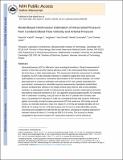Model-Based Noninvasive Estimation of Intracranial Pressure from Cerebral Blood Flow Velocity and Arterial Pressure
Author(s)
Kashif, Faisal Mahmood; Verghese, George C.; Heldt, Thomas; Novak, Vera; Czosnyka, Marek
DownloadVerghese_Model-based.pdf (1.013Mb)
OPEN_ACCESS_POLICY
Open Access Policy
Creative Commons Attribution-Noncommercial-Share Alike
Terms of use
Metadata
Show full item recordAbstract
Intracranial pressure (ICP) is affected in many neurological conditions. Clinical measurement of pressure on the brain currently requires placing a probe in the cerebrospinal fluid compartment, the brain tissue, or other intracranial space. This invasiveness limits the measurement to critically ill patients. Because ICP is also clinically important in conditions ranging from brain tumors and hydrocephalus to concussions, noninvasive determination of ICP would be desirable. Our model-based approach to continuous estimation and tracking of ICP uses routinely obtainable time-synchronized, noninvasive (or minimally invasive) measurements of peripheral arterial blood pressure and blood flow velocity in the middle cerebral artery (MCA), both at intra-heartbeat resolution. A physiological model of cerebrovascular dynamics provides mathematical constraints that relate the measured waveforms to ICP. Our algorithm produces patient-specific ICP estimates with no calibration or training. Using 35 hours of data from 37 patients with traumatic brain injury, we generated ICP estimates on 2665 nonoverlapping 60-beat data windows. Referenced against concurrently recorded invasive parenchymal ICP that varied over 100 millimeters of mercury (mmHg) across all records, our estimates achieved a mean error (bias) of 1.6 mmHg and SD of error (SDE) of 7.6 mmHg. For the 1673 data windows over 22 hours in which blood flow velocity recordings were available from both the left and the right MCA, averaging the resulting bilateral ICP estimates reduced the bias to 1.5 mmHg and SDE to 5.9 mmHg. This accuracy is already comparable to that of some invasive ICP measurement methods in current clinical use.
Date issued
2012-04Department
Massachusetts Institute of Technology. Department of Electrical Engineering and Computer Science; Massachusetts Institute of Technology. Research Laboratory of ElectronicsJournal
Science Translational Medicine
Publisher
American Association for the Advancement of Science (AAAS)
Citation
Kashif, F. M., G. C. Verghese, V. Novak, M. Czosnyka, and T. Heldt. “Model-Based Noninvasive Estimation of Intracranial Pressure from Cerebral Blood Flow Velocity and Arterial Pressure.” Science Translational Medicine 4, no. 129 (April 11, 2012): 129ra44–129ra44.
Version: Author's final manuscript
ISSN
1946-6234
1946-6242